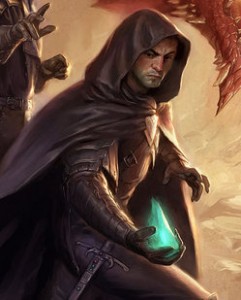
Artemis Entreri
Say the title five times fast or you’re a minion!
Jonathan (The core Mechanic), Michael (MadBrew Labs), and I have been talking a lot about villains lately. None of us are considering taking up the profession ourselves mind you. Well, maybe. It is a sweet gig in many respects, so I guess you have to at least entertain it, if for no other reason then to practice your diabolical laughter.
The main course of discussion has been: What defines a villain? What makes a villain tick in an RPG from a player’s viewpoint?
In storytelling mediums, a villain is a character who is dramatically opposed to the protagonist(s). Seems a little bland, right? Is Darth Vader a villain just because he opposes Luke Skywalker? Is Mr. Smith only a villain because he’s in Neo’s way?
Well…yes. In real life, evil is complicated. Who you think of as a villain could alter from day to day. Villainy in the active world mutates and bends to reality of our times, which itself shifts. It also varies according to the lens viewed from. But in a story, ambiguity disappears. Even if your main protagonist’s moral center vanished years ago, he’s still the protagonist. He drives your story. Anyone opposing him deeply is the villain. Opposition to the protagonist is the only thing that we can really express within the confines of a story. If we try to do much else, we are short-changing our protagonists, the characters that ostensibly we want our audience to actually care about. Protagonists drive the story, and villains are obstacles. What we strive for as GMs is to make our obstacles interesting and story-driving, and villains are no exception as obstacles go. In fact, a proper villain represents the spotlight obstacle, the major roadblock to our players progress.
In a book, or a movie, you can usually spare some screen time to the villain to add texture and create interest. RPGs are a bit different in that the protagonists, our PCs, must by necessity dominate “the screen”. It would be poor form to kick the players out of the game to watch a cutscene, or to have them playing other characters for long lengths of time. Players have invested a lot of time in their characters and want to see that time rewarded, not sliced up with the guy whose throat they are likely to be at sometime in the future. There are ways to introduce a villain’s back-story, but most of these methods require a disproportionate amount of effort for only modest gains in storytelling effectiveness.
What’s the BBEG doing then? Does he have a place? Of course he does. Your major villain’s main goal in an RPG is to be an obstacle to the players. Not just an ordinary obstacle, though. You major villain provides background opposition, and most importantly, provides motivation for the players to propel the story forward. The PCs may keep inspired to search for the ancient scrolls, but it has more meaning if there is an opposing force who they are attempting to keep the scrolls from.
Our villains are evil as a rule in RPGs. Incorrigible scoundrels, they perform the most heinous acts for the most insidious of motivations. But that raw, primal evil can be overdone, and players become immune to it. They build a tolerance towards your main villain’s evil acts and plans. To build your villain in more interesting ways, you must use different tools, and look at the role of your villain in different ways.
“What’s My Motivation?”
Before you do anything with your villain, you need to know what it is that motivates him. He wants to rule the world. Ok…why? What drives him to rule the world? If you don’t answer this question, your villain is like every other villain seeking world conquest. He’s four-color. Answer that question, dig in really deep, and your story begins to create itself. Your answer:
- Should be simple. Use big, powerful, universal emotions and concepts. The basic answer should be a word or two.
- Should be personal. Don’t abstract it too much. This is what your villain is actually trying to achieve. Take the word above and expand it with details.
- Gives the villain an instant personality. What kind of person takes these measures to satisfy his driving force?
Following these simple rules, let’s create a villain’s motivation. Our villain wants to rule the world for revenge. He is the last of a once proud race that was driven from the surface by the younger races of the world. Dominating the world will let him torture the people or the descendants of the people who caused him to see his race vanish into extinction.
Or another: Our villain wants to rule the world due to his pursuit of truth. He sees the world as a place devoid of true logic or rational. In the absence of true logic, there can be no true justice, no true peace or knowledge…no truth in anything. Only by reshaping the world in his image can he find the truth that he seeks.
Goals and Plots
The main interactions your PCs should have with your major villain will actually be with the villain’s plots, and his goals. Each villain has his ultimate goal, which is obviously an extension of his motivations. His ultimate goal is no small thing, however. This ultimate goal is broken down into several goals that, should the majority of them be achieved, result in the villain’s success, with what consequences that may bring.
Plots are the steps that villains take to achieve goals. The plots of your BBEG are of the highest importance because your PCs will interact with the villain through these plots, and will get to know your villain through the plots he attempts. From a perspective of active play, the schemes your villain hatches are his personality. Sometimes the goals that these plots serve will be impenetrable to the PCs, other times they will be crystal clear. But a scheme informs you who you’re dealing with. The villain who poison’s a village’s water supply is different than the villain who attempts to scare the villagers off with powerful illusions. And the BBEG who summons a colossus to tear down a castle is certainly different than the on who gathers a warhost for the same goal.
Plots are the lifeblood of your villain, so build them well. How many plots and goals a villain sets up (and most will have a few running concurrently) depends on the length of your campaign and the sort of story you want to tell. But make sure each scheme your villain hatches bears his unique signature somewhere within it.
The Minions Make the Man

Every good minion has a uniform
Every villain is a planner. Every planner has agents.
The henchman and minions a villain employs are probably the most powerful “signatures” a villain has. Extensions of his mind and body, when players come into conflict with his henchmen, they are actually fighting, by proxy, your villain. While your villain can employ unique agents and henchmen at times, it’s important that there be a “stormtrooper” effect –minions need a uniform. It doesn’t have to be a physical uniform. The henchmen don’t need to lockstep across the land. It can be subtle.
In my Blacktree Chronicle game. the major villain is a doppelganger lich. His minions are doppelgangers. But the PCs don’t know who is a doppelganger or who is not until they have found out. The main villain is a deciever, and his henchmen –his doppelgangers, are deceivers as well. When the doppelganger is finally revealed, the player’s instantly recognize their nemesis at the opposite end of it. Some adventures involve matters that Isami has no part in, and others do. The players have to be constantly on their toes because they don’t know who it is that is going to betray them, and who it is that is on their side. This intrigue and deception defines for the players the type of villain that the lich is. His plots are subtle and hard to see. His minions’ ‘uniform’ is that they are also deceptive and hard to find.
A Villainous Query
Here is my question: What do you think makes a villain memorable in the context of an RPG? What do you think are the most effective ways to empasize this?
Some notable Tweets:
Matt_Sheridan@gamefiend I think of that role as the villain you keep hearing about or seeing clues to, long before you actually get a shot at them.
captaincursor@gamefiend BBEG is there to theme and color the main plot. My BBEG is Vas, if players see vampires they know they are on the right track.
Hit me up on Twitter or in the comments with your thoughts. Always welcome your opinions!
Also, Jonathan is talking about villains too. Check out his insights.

“But the PCs don’t know who is a doppelganger or who is not until they have found out. ”
Not getting enough enough sleep Quinn?
I think gamers haven did a show on villains a while back, might be an interesting listen and you could compare what they had to say with what you and the other have come up with.
Well, I better get my voice on this out there soon!
I think that longevity and resilience are hallmarks of memorable villains.
The best way to emphasize these is to keep the beyond the character’s reach for an extended length of as well as have more than one scheme in play.
@freezer –lol. This is my lesson to not finish posts at 1:30 in the morning. I’ll get that fixed ASAP. Thanks for the spot!
@Madbrew –longevity and resilience…I like what you’re thinking! Ping me when you’ve got that post up.
I was thinking of Fear the Boot, not gamer’s haven.
I always liked the style of villain where the PCs know hes the bad guy but hes untouchable (out of reach, keeps getting away, is the king’s brother, etc) for some reason until later. The problem with this style is the PCs get fed up with it if hes untouchable too long or one of them comes up with a great idea to get him before you’re ready but you can’t reasonably say “no it won’t work”.
What about an institution/group/body of individuals rather than a single individual serving as the Big Bad? This is an angle I’m toying with in my current campaign.
There is a problem when the DM wants to protect the villain, so the PCs can’t touch them and get frustrated no matter what they do.
The solution:
Let the PCs beat the villain whenever they manage it. When the villain is dead or gone, have his replacement – brother/superior (the real architect of evil)/loyal servant, etc take his place.
When you design a villain have a plausible couple of more readily designed to take his place. In fact, design the campaign/adventure deliberately to take this into account.
So…is this a good example of a solid villain:
Our villain began his life as a well-intentioned marksman but rose to power as a politician who united several warrior clans to conquer the Western hemisphere due to neglect and a lack of support for his efforts of heroism. He seeks vengeance upon the heroes who once were his allies because they now seek what he once sought but now are gaining much more success than he once did, and this makes him envious.
I personally believe this will make for an interesting RPG, but being as this is my first RPG and thus my first villain, any input is appreciated because, I am quite the novice.